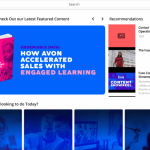Here we look at the many opportunities and challenges if you’re a learning content or technology provider making plans for marketing your elearning company in Europe – here in 2019 and beyond. Gordon’s recent post covered 6 Things You Must Know to Market Your LMS in Europe from the perspective of US vendors looking to enter the European market(s).
In this post we’ll cover issues for other types of elearning companies, and topics that are relevant to providers based within, as well as outside, Europe.

eLearning Terminology
Europe is not one coherent market for learning technologies and content or online courses. Different countries will use quite different terms for learning management systems. Many continental countries are more interested in MOOCs and SPOCs for corporate learning for example. Even terms such as eLearning and LMS can have different connotations in different countries. e-Learning centres are very common in many countries as places to visit for learning activities.
Learning Standards
Many Continental European countries have been much less interested in SCORM and other standards, and a much more open culture around open source has developed. Europe has spawned quite a number of open source LMS, but closed-source, proprietary systems are also very common and these tend not to follow standards like SCORM. Large libraries of SCORM content are not widely available in much of mainland Europe and creation and curation of content that’s contained within an LMS or MOOC is more popular. Similar to the US stance, it seems that the UK is much more keen on SCORM as a standard than its mainland European counterparts.
European Acceptance of Learning Technologies
Different European states demonstrate differing levels of maturity in using learning technologies. This can be attributed to cultural factors regarding the perceived business value of learning and of course technology factors. Internet connectivity levels and costs vary greatly across the EU. Mobile phone usage and ownership patterns also vary greatly, as does social media usage – all of which has a bearing on the likely maturity of the market towards elearning and learning technologies.
These and other factors make differing countries require differing approaches. Scandinavia is the most advanced and are net exporters of elearning and learning technologies. The UK is still a very vibrant market and northern Europe is proving robust as well. The German market is coming to life and will prove very large indeed over the next few years. France has enjoyed considerable growth but recently has slowed down. Spain is recovering and exporting its skills widely to South America as well. Eastern Europe has benefited massively from EU structural funds and much of the infrastructure is arriving for elearning. We anticipate strong growth in these countries.
Legal frameworks for training in the EU
While the EU is notionally one market, different countries have very different approaches to how training is delivered and recorded in companies. Subsidy regimes offered to employers to train their workforces mean differing training programmes, and recording and reporting mechanisms, must be managed by employers.
Differing stakeholders such as Chambers of Commerce and Trade, Trades Unions and vocational education and training (VET) providers often play important roles in the corporate L&D market. Trades Unions and worker’s councils are particularly concerned around data protection issues. GDPR will play a greater role.
Procurement rules
The EU has created a single market for public sector entities to purchase goods and services. These tender opportunities must be advertised in the Official Journal of the European Union (OJEU). Organisations tendering for these opportunities must follow the rules and understand the terminologies used, such as CPVs (Common Procurement Vocabulary) and NUTS codes.
Smaller projects will not appear in the OJEU, but public sector procurement processes and rules will still have to be followed. There are numerous services offering access to these opportunities that are usually referred to as “below threshold”. Most tendering processes are overly complex and revolve around RFPs (Request for Proposals). In some cases these are only made available after an ITT process (Invitation to Tender), which is a pre-tendering process to see if the vendor meets the legal requirements to supply the public sector. Frameworks of approved suppliers are often created and awards of work are then made over the lifetime of the framework. Being on a public sector framework is no guarantee of work.
Supplying the public sector requires a wide range of policies and procedures to be in place and the procurer will undertake financial due diligence.
In completing an RFP for a public sector contract, you are in effect writing your own contract and will therefore drink your own champagne. Public sector procurement officers do not take kindly to being bombarded by e-mails and brochures and endless telephone calls. Any clarifications or changes made during the process in response to vendor questions will be shared with all vendors.
The good news is you will find out who has won and how your RFP was rated.
There is without doubt bias in the system, and smaller awards will usually go to the local vendor. The Scots will often buy from the Scots and the French will buy French 😉 Some countries are more open, but many try to nurture their indigenous supply base, or forge partnerships and consortia. Many governments are trying to encourage SMEs (SMBs to many of our global readers) where possible.
It is worth remembering that the public sector (including health, health and social care, defence, many utilities, local government and national government agencies) represents about 40% of the market. This excludes K12 and higher education (Universities), and overlaps with Vocational Education and Training (VET).
Language and culture
Many European countries recognise different cultures and languages. In the UK, Welsh is recognised as an official language and government and utilities supplying services in Wales are obliged to offer materials in Welsh. Spain is another country that has multiple language requirements.
Overall learning cultures vary hugely across the region, which has a major effect on those trying to market an elearning company in Europe. Within northern Europe and Scandinavia, the continual investment in learning and development of existing employees is considered important and is most commonly used to address skills gaps. In contrast, southern Europe has a greater tendency to addresses skills by recruiting people who can fill the gap from the moment of hire and less attention is given to up-skilling.
This is of course reflected by the number of training organisations supported in different countries and how training budgets are allocated… or spent on recruitment as the case may be.
The economic make up of a country
The economic make up of a country also impacts upon the acceptance and utilisation of elearning and learning technologies.
The UK is highly dependent upon banking and finance and has a large number of banks, many of them international. The nature of this business and the importance of legal compliance has meant that elearning for financial services is in high demand. When legislation and the overall industry environment change quickly, online training content and anytime, anywhere learning is well suited.
Other European countries have economies with very different industrial or agricultural mixes, which therefore shapes their market potential.
Can We Help You?
We hope the above information is useful for those looking to promote an elearning company in Europe. However, if you’d like to discuss your situation or get some expert help in navigating the tricky European landscape, feel free to contact us here at Learning Light.

David Patterson
Lead eLearning Consultant
About David
Our lead elearning consultant David Patterson is an expert in training technologies such as learning management systems, and in elearning best practices.
He has helped many public and private sector organisations across the UK, Europe and worldwide to create and deliver engaging, effective elearning.
David is joint author of several research papers including the highly acclaimed Learning Light reports on the UK elearning market.













